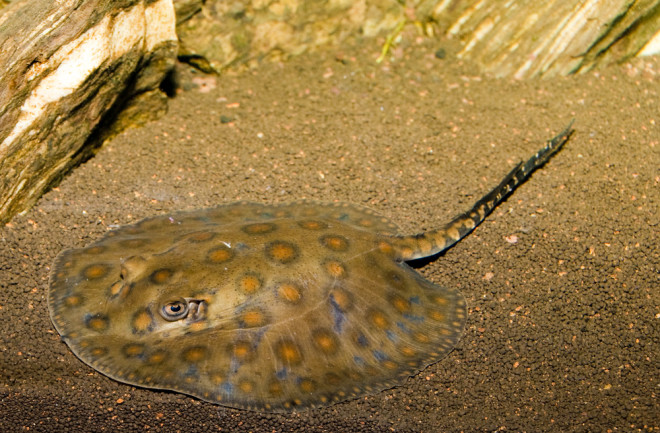Sometimes opposites attract. And sometimes it only seems that way. In February 2024, a female stingray at an aquarium in North Carolina started showing signs of pregnancy while sharing her tank with several male sharks, spawning theories that the male sharks had impregnated her.
But some scientists state that these theories are as improbable as they sound: No matter the circumstances, they say, sharks cannot impregnate stingrays.
So, why were some people so convinced that a stingray and a shark mated, and why are some scientists so sure that that isn’t the case?
Read More: The Mystery of Male Pregnancy and Birth in Seahorses
Charlotte: A Special Stinger
Charlotte, a strangely round stingray, swims around a 2,200-gallon storefront aquarium at the Aquarium and Shark Lab in Hendersonville, North Carolina, and is something special. At around 12 to 16 years old, she’s an older ray — the shade of rust and the size of a serving plate — and hasn’t seen a male of her species in almost a decade.
So, when aquarium staff started to see Charlotte’s body bulging outwards, they were worried, wondering whether the bulge was a tumor or a product of overfeeding. They ran an ultrasound right away, though the results revealed the swelling was a sign of something different: Charlotte was pregnant with pups, due sometime in February or March.
“Our stingray, Charlotte, is expecting,” the aquarium announced on Facebook on February 6, 2024. “The really amazing thing is we have no male ray.”
Read More: Crocodiles Are Particularly Good Mothers
The Case For Stingray-Shark Mating
Charlotte didn't have any contact with male stingrays, but she did have contact with male white-spotted bamboo sharks for several months prior to February. Some suspected that an unprecedented incident of interspecies mating was at the heart of her pregnancy.
“Just because something has not happened or has not been documented does not make it impossible,” the aquarium added on Facebook. “Science is discovery.”
Supporting this theory were the bite marks on Charlotte’s body, a typical sign of shark mating: Studies show that many male sharks sink their teeth into the fins or backs of female sharks as they mate, suggesting to some that the same could have happened to Charlotte.
The Case Against Stingray-Shark Mating
The bite marks could convince some people that Charlotte’s pregnancy was the product of stingray-shark mingling, though they could not convince all. In fact, the theory of interspecies fraternization is far from persuasive for some scientists, who say it is impossible that Charlotte was impregnated by a shark.
Though the mating of two similar species can sometimes produce offspring, round stingrays and white-spotted bamboo sharks are not all that similar, these scientists say. They’re incompatible in size and anatomy, and besides those incompatibilities, they’re also genetically incongruent, with their DNA incapable of creating offspring, Kady Lyons, a research scientist at the Georgia Aquarium, told the Associated Press.
“We should set the record straight,” Lyons added to the Associated Press. “There aren’t some shark-ray shenanigans happening here.”
Read More: Orca Killer Whale Moms Pay a Steep Price to Feed Their Adult Sons
The Truth of Charlotte’s Pregnancy
So why was Charlotte suddenly pregnant, predicted to deliver as many as four pups? According to Lyons, who is unassociated with the North Carolina team, it’s probable that Charlotte became pregnant asexually, through the process of parthenogenesis.
Stingrays typically reproduce sexually, with females producing both egg cells and byproduct cells called polar bodies. Both cells contain genes, though not enough genes to generate embryos. In typical pregnancies, therefore, the female egg cells fuse with male sperm cells to generate embryos, while the female polar bodies wither away. But in parthogenesis pregnancies, the female egg cells fuse with the female polar bodies, acquiring enough genes to generate embryos without the genetic additions of a male.
Testing once the pups are born could confirm whether they are the product of parthenogenesis. If they are, Charlotte’s pregnancy would represent the first recorded instance of parthenogenesis in this particular species of stingray, though Lyons told the Associated Press that the outcome wouldn’t be particularly surprising.
“Nature finds a way of having this happen,” she told the Associated Press, with these peculiar pregnancies appearing in several other species of cartilaginous fish, including bamboo sharks and zebra sharks, in the past.
Read More: Why Do Frogs Keep Trying to Mate with the Wrong Things?
